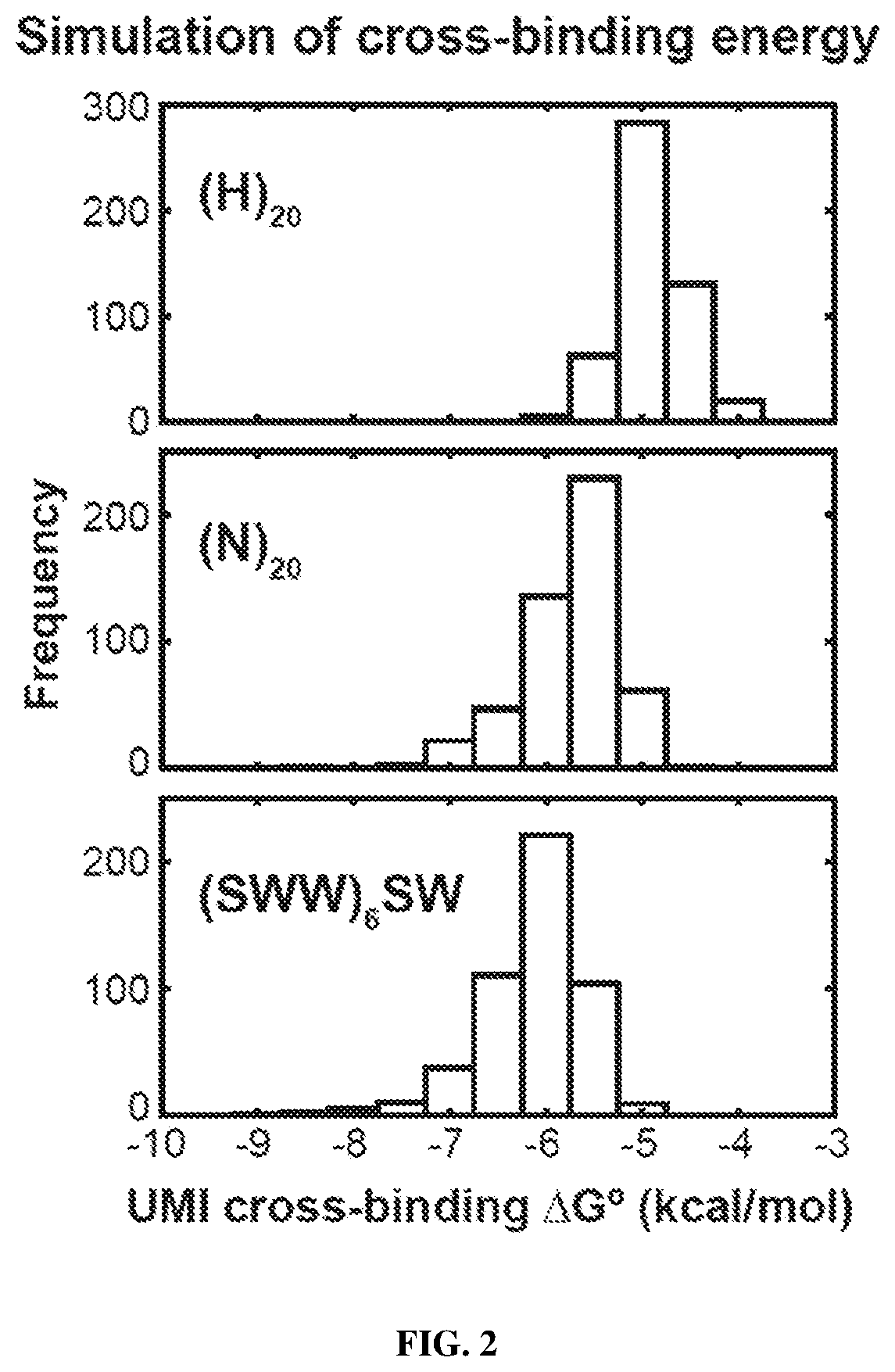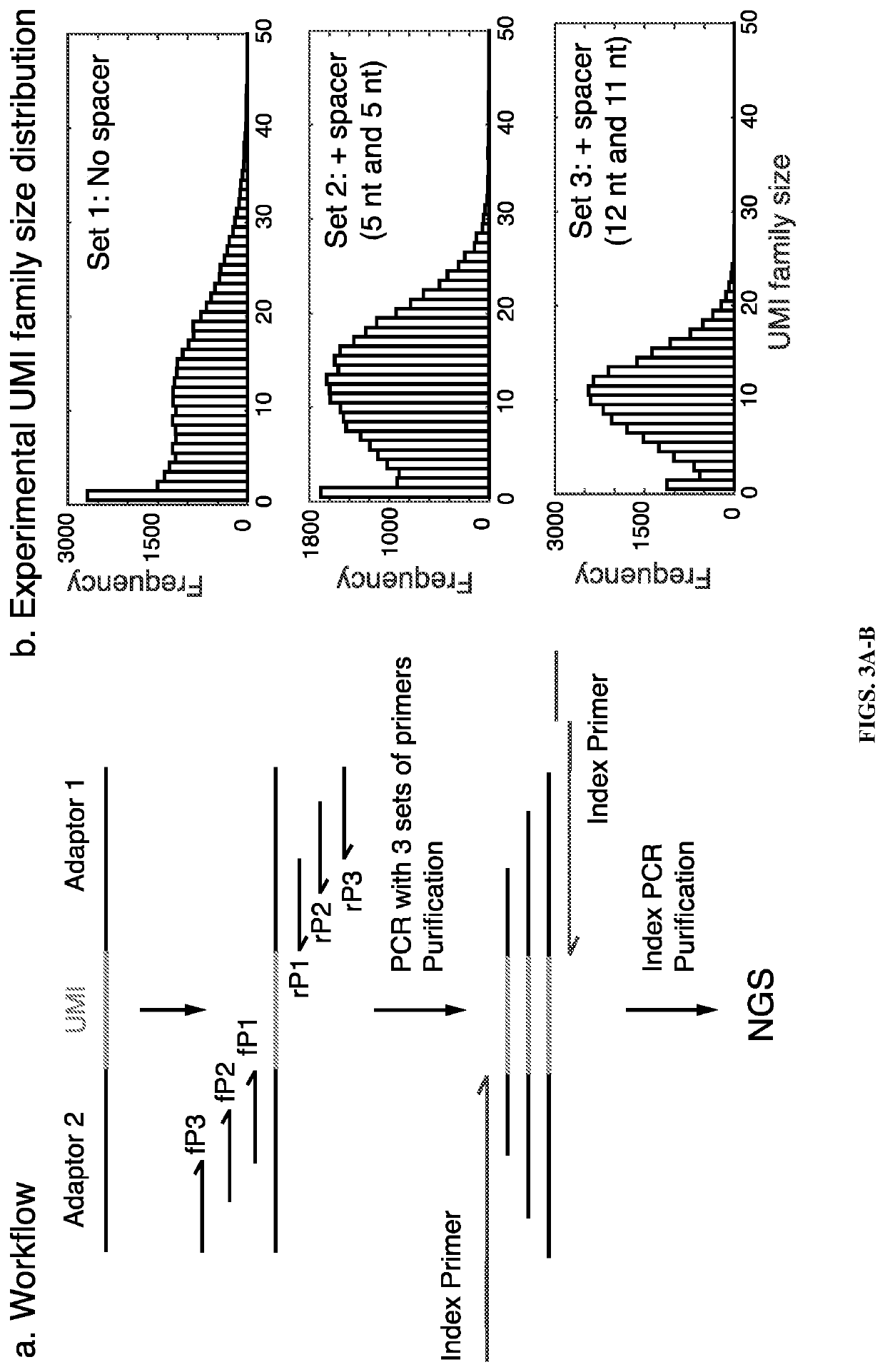Quantitative amplicon sequencing for multiplexed copy number variation detection and allele ratio quantitation
a technology of multiplexed copy number variation and quantitative amplicon sequencing, applied in the field of molecular biology and medicine, can solve the problems of difficult quantitative analysis, inability to detect 1% extra copies, and inability to perform simultaneous analysis of multiple genomic regions of ish technologies
- Summary
- Abstract
- Description
- Claims
- Application Information
AI Technical Summary
Benefits of technology
Problems solved by technology
Method used
Image
Examples
example 1
on Results
[0100]An exemplary calibration experiment of the ERBB2 QASeq panel was performed on a normal cell line gDNA sample NA18562, which should not contain ERBB2 amplifications, to analyze the quantitation variability and potential LoD. The workflow was as described in the “QASeq Workflow” section. Taq polymerase was used in all the PCR steps. Denaturation was performed at 95° C., and annealing / extension was performed at 60° C. (except for the universal PCR step, in which annealing / extension was performed at 68° C.). Because all original molecules with UMIs attached need to be present in the NGS output, 15 reads were reserved for each molecule / UMI. For an input of 2500 haploid genomic copies and a 20-amplicon panel, the total reads needed is about 2×2500×20×15=1,500,000. Note that each of the strands in one DNA duplex carries a different UMI in this workflow, so 2500 haploid genomic copies=5000 molecule number=8.3 ng gDNA. This experiment was performed on an Illumina MiSeq instru...
example 2
tion Results in FFPE Samples
[0103]Two FFPE slides were analyzed using the example ERBB2 panel described in the “Multiplexed PCR Panel Design” section and Example 1. The FFPE slides (purchased from Asterand) were from the same lung cancer tumor, which is not expected to contain ERBB2 CNV. First, DNA was extracted using a QIAamp DNA FFPE Tissue Kit (Qiagen), and >6 μg of DNA per sample was obtained. The libraries were prepared using the same methods as described in Example 1. 8.3 ng extracted DNA was used for each library, which is equivalent to 2500 haploid genomic copies and 5000-molecule input. The number of NGS reads reserved for each library (1,500,000 reads) was the same as 2500 haploid genomic copies input cell line gDNA libraries.
[0104]Data analysis was performed using the same methods as described in Example 1. A similar pattern of UMI family size distribution to the cell line gDNA libraries was obtained (FIG. 8A). The unique UMI numbers were smaller than cell line gDNA libra...
example 3
itation Results in Spike-In Clinical FFPE Samples
[0106]A 100-plex QASeq panel was used to quantitate the ploidy of ERBB2 in breast cancer FFPE samples. 50-plex were in the ERBB2 gene region (see Table 3 for primer sequences; primer names have “ERBB2” in them), and 50-plex were in the short arm of Chromosome 17 as the Reference (see Table 3 for primer sequences; primer names have “Ref” in them).
[0107]Two previously characterized FFPE DNA samples (1 “normal” sample and 1 “ERBB2 amplified abnormal” sample) were mixed to generate 2.5%, 5%, and 10% ERBB2 FEC samples. The “normal” sample DNA was extracted from a FFPE lung cancer sample (purchased from Asterand), which should not have ERBB2 amplification (FEC=0%); the “ERBB2 amplified abnormal” sample DNA was extracted from a FFPE breast cancer sample (purchased from OriGene), which has a ERBB2 FEC of 78%. The sample input was 8.3 ng DNA per library (quantitated by qPCR). The “normal” sample was tested with 5 replicated NGS libraries prepa...
PUM
| Property | Measurement | Unit |
|---|---|---|
| Temperature | aaaaa | aaaaa |
| Fraction | aaaaa | aaaaa |
| Time | aaaaa | aaaaa |
Abstract
Description
Claims
Application Information
 Login to View More
Login to View More - R&D
- Intellectual Property
- Life Sciences
- Materials
- Tech Scout
- Unparalleled Data Quality
- Higher Quality Content
- 60% Fewer Hallucinations
Browse by: Latest US Patents, China's latest patents, Technical Efficacy Thesaurus, Application Domain, Technology Topic, Popular Technical Reports.
© 2025 PatSnap. All rights reserved.Legal|Privacy policy|Modern Slavery Act Transparency Statement|Sitemap|About US| Contact US: help@patsnap.com



